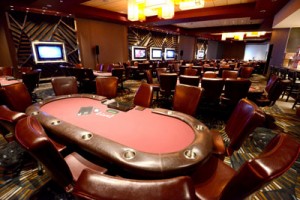 In recent years poker has seen an explosion in popularity of ultra-high-stakes tournaments. Tournaments with $100,000 buy-ins are now held about a dozen times each year, and every two years we get the $1,000,000 buy-in Big One for One Drop tournament at the World Series of Poker.
In recent years poker has seen an explosion in popularity of ultra-high-stakes tournaments. Tournaments with $100,000 buy-ins are now held about a dozen times each year, and every two years we get the $1,000,000 buy-in Big One for One Drop tournament at the World Series of Poker.
These events portray the poker world as thriving, with dozens and dozens of players capable of playing for unimaginable stakes.
Some players have propped up their individual tournament stats in these tournaments to the point where the average person on the street hears “Poker Pro” and thinks “Multimillionaire.”
Unfortunately, it’s all a lie or at the best an exaggeration, the stats, the massive buy-ins, and the jaw-dropping paydays are all fraudulent.
The bastardization of tournament metrics
During the Poker Boom a tournament’s success was measured by its ability to grow year-over-year and beat its competitors. As the Poker Boom began to wane tournament organizers decided to get creative with their use of stats.
The first misinformation campaign was the introduction of reentry events and slashing the buy-ins, so a $10,000 tournament that attracted 600 players in 2006 can still be propped up as “growing” by lowering the buy-in to $3,500 and allowing reentries.
“Hey look, we got 1,100 entrants. Almost double what we pulled in during the Poker Boom. Poker is alive and well!”
Problem is of course the overall prize-pool is still lower than 2006, and only 750 of those entries are unique players. Yes you got an extra 150 players, but it took cutting the buy-in by a third
Another way tournament organizers have decided to push their product as growing is by juicing prize-pool numbers with these massive buy-in tournaments.
Daniel Colman just won $15 million in the Big One for One Drop tournament… oh wait, he only had 10% of himself –still a nice payday, but $1.5 million is not the attention-grabbing headline that $15 million is.
And this isn’t simply a One Drop problem. Selling pieces, swaps, and staking deals extends to Super-High-Roller events, $5k and $10k Championship tournaments, and to a lesser extent to events with 3- and 4-figure buy-ins.
I don’t place blame on Colman or anyone else who sells percentages of themselves in tournaments (even legitimate multi-millionaire poker pro Daniel Negreanu sold half his action for the One Drop event) it’s a necessary evil in order to survive the variance associated with tournament poker. It’s not as bad in smaller events, but once you get into Super-High-Roller territory the percentages the players have of their action is worrisome when you consider how they are being portrayed.
For lack of a better word these events are complete shams. It’s a fraud perpetuated by the poker world to give the general public the appearance they are playing for stakes and cash prizes they simply are not, and the players are more than happy to go along with it because it makes them look like ballers by an order of five or ten.
If the average poker player in One Drop had 20% of themselves (with an average of five backers each) than the tournament was not the 42 player $1,000,000 buy-in event we were sold, it was a 200 player, $200,000 buy-in event that saw 42 players act as representatives for the other 150 or so backers.
$100k Super-High-Rollers are basically the same. Maybe the players have a bit more of their own action, say 25%, but that just means these events are $25k tournaments masquerading as $100,000 tournaments.
So my question to poker tournament organizers and poker players is: Why lie? Why deceive the general public to make it appear you are playing for stakes you are not playing for? Why not just play for stakes you can actually partake in?
Imagine if we learned that casinos were lying about the jackpot payouts they were handing out? Suppose the little old lady who was photographed with the $1,000,000 check was part of a group assembled by the casino that pooled all their nickels together so they could play the $1 slots and try to hit the bigger jackpot.
I know, bad analogy, but essentially this is what tournament organizers and the players participating in these events are doing, they are making it seem like they are playing for stakes they simply aren’t playing for. And it seems like the only reason is to lure in new players.
I’m all for bringing new players into poker, but I think we should be a bit more upfront about what they are getting into. The idea that if they climb the ladder they can be playing in these events is a pipe dream: Not only will virtually all of them fail, but the select few that do succeed still can’t afford to play in these events!
The money is real, but the way it’s being distributed is an out and out lie.
Just cut it in half
And as I mentioned above, this extends all the way down the poker food chain to the tournament grinders travelling the circuit and playing tons of smaller buy-in events.
Whenever you see a poker player holding up their newly won bracelet/ring/trophy in front of hundreds of thousands of dollars and wonder why they are surrounded by a dozen well-wishers during THEIR big moment there is a reason for that. Those well-wishers most likely bought a piece of that player’s action.
Even in WSOP Circuit Events, with $1,500 buy-ins, the vast majority of poker pros are being staked and have at best 50% of their own action, probably less, and probably much less when you factor in how many are in makeup.
100% up to $3,000 Bonus
Bovada is our most recommended ONLINE CASINO and POKER ROOM for US players with excellent deposit options. Get your 100% signup bonus today.


Leave a Reply
You must be logged in to post a comment.